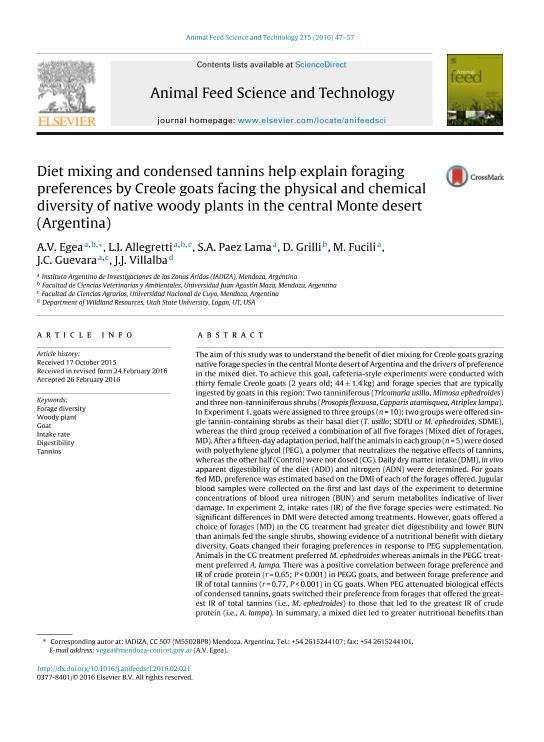Mostrar el registro sencillo del ítem
dc.contributor.author
Egea, Angela Vanina

dc.contributor.author
Allegretti, Liliana Inés

dc.contributor.author
Paez Lama, Sebastián Antonio

dc.contributor.author
Grilli, Diego Javier

dc.contributor.author
Fucili, Mercedes

dc.contributor.author
Guevara, Juan Carlos

dc.contributor.author
Villalba, J. J.
dc.date.available
2018-05-18T20:48:52Z
dc.date.issued
2016-05
dc.identifier.citation
Egea, Angela Vanina; Allegretti, Liliana Inés; Paez Lama, Sebastián Antonio; Grilli, Diego Javier; Fucili, Mercedes; et al.; Diet mixing and condensed tannins help explain foraging preferences by Creole goats facing the physical and chemical diversity of native woody plants in the central Monte desert (Argentina); Elsevier Science; Animal Feed Science and Technology; 215; 5-2016; 47-57
dc.identifier.issn
0377-8401
dc.identifier.uri
http://hdl.handle.net/11336/45667
dc.description.abstract
The aim of this study was to understand Creole goats´ preference for native forage species in the central Monte desert of Argentina. To achieve this goal, cafeteria-style experiments were conducted with thirty female Creole goats (2 years old; 44 ± 1.4 kg) which were offered five woody forage species goats typically ingest in this region: Two tanniniferous (Tricomaria usillo, Mimosa ephedroides) and three non-tanniniferous shrubs (Prosopis flexuosa, Capparis atamisquea, Atriplex lampa). In Experiment 1, goats were assigned to three groups (n = 10); two groups were offered single tannin-containing shrubs as their basal diet (T. usillo; SDTU or M. ephedroides, SDME), whereas the third group received a combination of all five forages (Mixed diet of forages, MD). After a fifteen-day adaptation period, half the animals in each group (n=5) were dosed with polyethylene glycol (PEG), a polymer that neutralizes the negative effects of tannins, whereas the other half (Control) were not dosed (CG). Daily dry matter intake (DMI) and in vivo apparent digestibility of the diet (ADD) and nitrogen (ADN) was determined. For goats fed MD, preference was estimated based on the DMI of each of the forages offered. Jugular blood samples were collected on the last day of the experiment to determine concentrations of blood urea nitrogen (BUN) and serum metabolites indicative of liver damage. In experiment 2, intake rates (IR) of the five forage species were estimated. No significant differences in DMI were detected among treatments. However, goats offered a choice of forages (MD) in the CG treatment had greater diet digestibility and lower BUN than animals fed the single shrubs, showing evidence of a nutritional benefit with dietary diversity. Goats changed their forage preference in response to PEG supplementation. Animals in the CG treatment preferred M. ephedroides whereas animals in the PEGG treatment preferred A. lampa. There was a positive correlation between forage preference and IR of crude protein (r = 0.65; P < 0.001) in PEGG goats, and between forage preference and IR of total tannins (r = 0.77, P < 0.001) in CG goats. When biological effects of condensed tannins were attenuated by PEG goats switched their preference from forages which offered the greatest IR of total tannins (i.e., M. ephedroides) to those which led to the greatest IR of crude protein (i.e., A. lampa). In summary, a mixed diet led to greater nutritional benefits than single diets which contribute to explain the diverse array of food items goats typically show when browsing in the central Monte desert of Argentina. Our results also show that CP, tannins and plant structure (which offer variable intake rates) play significant roles in goats´ foraging preferences in this environment.
dc.format
application/pdf
dc.language.iso
eng
dc.publisher
Elsevier Science

dc.rights
info:eu-repo/semantics/openAccess
dc.rights.uri
https://creativecommons.org/licenses/by-nc-sa/2.5/ar/
dc.subject
Woody Plant
dc.subject
Goat
dc.subject
Intake Rate
dc.subject
Digestibility
dc.subject
Tannins
dc.subject
Digestibility
dc.subject.classification
Producción Animal y Lechería

dc.subject.classification
Producción Animal y Lechería

dc.subject.classification
CIENCIAS AGRÍCOLAS

dc.title
Diet mixing and condensed tannins help explain foraging preferences by Creole goats facing the physical and chemical diversity of native woody plants in the central Monte desert (Argentina)
dc.type
info:eu-repo/semantics/article
dc.type
info:ar-repo/semantics/artículo
dc.type
info:eu-repo/semantics/publishedVersion
dc.date.updated
2018-04-18T20:20:54Z
dc.journal.volume
215
dc.journal.pagination
47-57
dc.journal.pais
Países Bajos

dc.journal.ciudad
Amsterdam
dc.description.fil
Fil: Egea, Angela Vanina. Consejo Nacional de Investigaciones Científicas y Técnicas. Centro Científico Tecnológico Conicet - Mendoza. Instituto Argentino de Investigaciones de las Zonas Áridas. Provincia de Mendoza. Instituto Argentino de Investigaciones de las Zonas Áridas. Universidad Nacional de Cuyo. Instituto Argentino de Investigaciones de las Zonas Áridas; Argentina. Universidad "Juan Agustín Maza"; Argentina
dc.description.fil
Fil: Allegretti, Liliana Inés. Universidad "Juan Agustín Maza"; Argentina. Consejo Nacional de Investigaciones Científicas y Técnicas. Centro Científico Tecnológico Conicet - Mendoza. Instituto Argentino de Investigaciones de las Zonas Áridas. Provincia de Mendoza. Instituto Argentino de Investigaciones de las Zonas Áridas. Universidad Nacional de Cuyo. Instituto Argentino de Investigaciones de las Zonas Áridas; Argentina
dc.description.fil
Fil: Paez Lama, Sebastián Antonio. Consejo Nacional de Investigaciones Científicas y Técnicas. Centro Científico Tecnológico Conicet - Mendoza. Instituto Argentino de Investigaciones de las Zonas Áridas. Provincia de Mendoza. Instituto Argentino de Investigaciones de las Zonas Áridas. Universidad Nacional de Cuyo. Instituto Argentino de Investigaciones de las Zonas Áridas; Argentina
dc.description.fil
Fil: Grilli, Diego Javier. Universidad "Juan Agustín Maza"; Argentina. Consejo Nacional de Investigaciones Científicas y Técnicas; Argentina
dc.description.fil
Fil: Fucili, Mercedes. Consejo Nacional de Investigaciones Científicas y Técnicas. Centro Científico Tecnológico Conicet - Mendoza. Instituto Argentino de Investigaciones de las Zonas Áridas. Provincia de Mendoza. Instituto Argentino de Investigaciones de las Zonas Áridas. Universidad Nacional de Cuyo. Instituto Argentino de Investigaciones de las Zonas Áridas; Argentina
dc.description.fil
Fil: Guevara, Juan Carlos. Consejo Nacional de Investigaciones Científicas y Técnicas. Centro Científico Tecnológico Conicet - Mendoza. Instituto Argentino de Investigaciones de las Zonas Áridas. Provincia de Mendoza. Instituto Argentino de Investigaciones de las Zonas Áridas. Universidad Nacional de Cuyo. Instituto Argentino de Investigaciones de las Zonas Áridas; Argentina
dc.description.fil
Fil: Villalba, J. J.. Utah State Universit. Department of Wildland Resources; Estados Unidos
dc.journal.title
Animal Feed Science and Technology

dc.relation.alternativeid
info:eu-repo/semantics/altIdentifier/url/http://www.sciencedirect.com/science/article/pii/S0377840116300712
dc.relation.alternativeid
info:eu-repo/semantics/altIdentifier/doi/https://doi.org/10.1016/j.anifeedsci.2016.02.021
Archivos asociados
